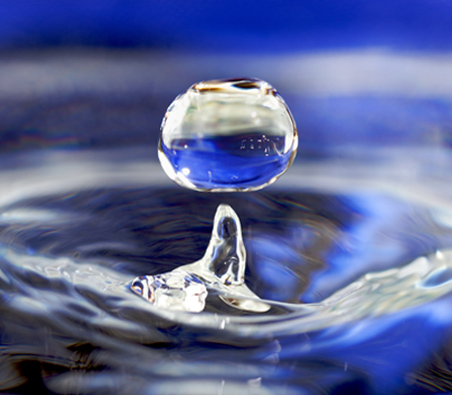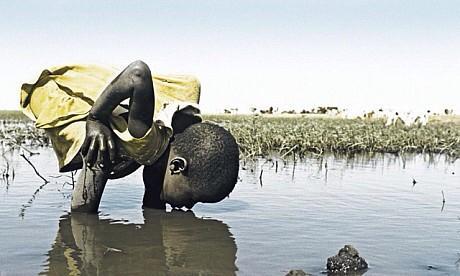Hydration
 We can last about 50 days with no food, 5 days with no water and 5 minutes without oxygen. If we are gassed with cyanide we’ll last about 15 seconds as the cyanide shuts down ATP in the mitochondria. The mitochondria also progressively shut down ATP if the body loses free water – death is not quite so dramatic but its only 5 days away.
We can last about 50 days with no food, 5 days with no water and 5 minutes without oxygen. If we are gassed with cyanide we’ll last about 15 seconds as the cyanide shuts down ATP in the mitochondria. The mitochondria also progressively shut down ATP if the body loses free water – death is not quite so dramatic but its only 5 days away.
The problem is that most people have some level of dehydration i.e. not enough H2O penetrating the cell membrane to fill the cell. Water needs electrolytes for electrical potential to move through the cell wall.
Water also needs structure. H2O is a complex molecule with astonishing properties, one of which is acquiring and holding shifts in the shape of its molecular bonds after contact with substances or shocks. For example the water splashing down a mountain stream in the forest is vastly better at hydrating cells than water through the municipal pump station.
So what is “Bound Water & Free Water”
Water inside the cells is chemically involved in most functions.
It’s a hydrolysis reaction – happening at vast levels – H2O splits into H+ (hydrogen) and HO (hydroxl). This is most of the water in the body – it is called “bound water”.
We must have a reserve of “free water” available so hydrolysis keeps running. As soon as free water is depleted the body begins managing drought, systematically shutting down functions such as the energy cycle of the cell.
Of course there’s still a lot of body water keeping a lot of things going, but something somewhere will have to lose out.
Histamine is a possible reaction as it increases to manage drought. For example to prevent the body’s loss of moisture via the lung a histamine flush could decrease the size of the brochioles and thicken the mucous, classic conditions for asthma.
Breaking a Drought
Dehydration is a part of every chronic health condition but drinking lots of water and passing clear urine doesn’t mean hydration. Caffeine and alcohol are diuretics, they dehydrate cells.
Most people are dehydrated to some extent and it takes from a few days to three weeks of diligent hydration to fully restore a free water surplus to cells.
Water must be pure with minerals for electrolyte potential.
A good electrolyte is natural well mineralised salt. Himalayan salt is as good as it gets and can be made as Sole. Add just enough to taste minerals not salt.
Coconut water is a good option. A powder of dehydrated coconut water plus good minerals is now available.
Assessing Hydration
Signs of dehydration are dark yellow urine, dry cool skin, headache, muscle cramps, tiredness. Take a pinch of skin on the back of your hand – does it fail to straighten out and stay up and folded?
It’s likely to take at least a week to re-hydrate and more likely a month. A good rehydration program requires pure mineralised water, a glass of water each hour or so all day with every second glass containing a suitable electrolyte.
A reliable measure for hydration is by Phase Angle using BioImpedance Analysis if the machine is sophisticated enough to use tape on electrodes. The technology measures cellular hydration by comparing water inside and outside the cells. It’s a more advanced form of the bio-impedance analysis used in the body composition bathroom scales. Practitioners using phase angle see that nearly everyone is dehydrated.
The best way to know if you’re well hydrated is experience.
Make a program to include electrolytes into good water for about 3 weeks which is long enough to get the ‘properly hydrated’ feeling. After that it seems automatic to drink enough water, you just know when its low.
Water Filters.

Filtering town water means cleaning out all the toxic substances and replacing some minerals.
Structure is also important, which relates to the last environment the water passed through before it reached our drinking glass. Carbon smooths a chaotic imprint.
One form of toxin is a ‘detoxification by-product’. That is the remains of the body parts of all the bacteria and other organic forms which are killed by chlorine.
Of course there’s metals such as aluminium and fluoride.
Reverse osmosis is very good but RO Filters strip all minerals, they should have an after cartridge to return minerals to the water. Or add Himalayan salt Sole.
Benchtop filters are also good. They have zeolite and ion exchange resins to catch heavy metals, with silica and other mineral layers plus magnets in the tap for structure.
A benchtop clay filter is pretty good for rainwater and Sole can add minerals.
Hydrolysis – a seriously important chemical reaction.
Hydrolysis is simply the separation of water (H2O) into a hydrogen (H+) and hydroxyl (OH-). These two molecules take part in a myriad of chemical reactions throughout the body.
For example the energy cycle of each cell uses H+ and OH- to create the energy molecule (ATP). Reduce the water, reduce the energy output.
Most of the water in the body is fully involved in these chemical reactions, this is called the “bound water”. To keep the reactions going there must be a reserve of “free water”. As soon as the free water is depleted the body begins to manage drought, systematically shutting down functions.
The extreme shutdown is death, which happens in a few days. But dehydration sneaks in quietly, thirst sensation loses sensitivity, tiredness may be a first symptom and chronic disease a likely outcome.
It’s safe to say that dehydration is a factor in all chronic disease and pain syndromes.


